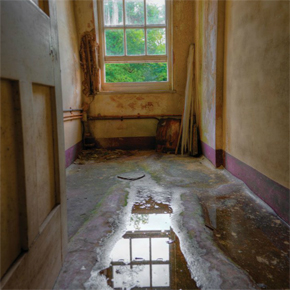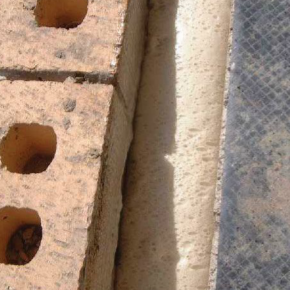
Learning from Doris: Future-proofing our building stock
In the latest issue of PSB Magazine, Simon Storer, chief executive of BRUFMA, highlights the benefits of installing PIR and PUR insulation to prevent flood damage.
Storm Doris wreaked havoc throughout Britain in February, with gusts hitting 100mph and heaving rain pounding homes right across the country.
Similarly, in the winter of 2016, extreme storms led to the highest river flow levels ever recorded, and resulted in widespread flooding and properly damage that cost £1.3bn and led to many people being evacuated from their homes.
Despite the significant investment in flood defences that has taken place over recent years, around five million properties in the UK today are at risk of flooding.
Increased risk of flooding
The intergovernmental Panel on Climate Change (POC) has warned that extreme weather events such as these are likely to become more prevalent, with an increased risk of intense rainfall and flooding.
Projections from the Committee on Climate Change suggest that periods of intense rainfall could increase in frequency by a factor of five, meaning more homes would be exposed to a greater risk of flood damage. Wetter weather poses significant challenges for our building stock.
Future-proofing UK houses
Efforts to tackle the UK’s housing crisis mean we need to build more homes, but these homes need to be future-proof, both in terms of energy efficiency and safety. The benefits of energy efficiency improvements are well-documented, however, it is equally important that homes are protected from flooding.
 A key solution to ensure this, and reduce the costs associated with flooding, is to install property level flood resilience measures.
A key solution to ensure this, and reduce the costs associated with flooding, is to install property level flood resilience measures.
In addition to building future-proof homes, it is important that existing homes are also protected. The Government wants to drive one million energy efficiency retrofits by 2020, but should also take into consideration the flood resilience of thermal insulation in high risk areas.
Currently, when a building is flooded, the tendency is to go with the status quo, replacing damaged plasterboard, flooring and insulation with like-for-like materials.
However, highly resistant and resilient replacement products should be used to ensure that properties are better protected from subsequent flooding.
Closed cell PIR and PUR insulation does not absorb or transport moisture, yet retains its high thermal performance and has been recognised as the preferred solution when seeking to improve the flood resilience of buildings.
Improving flood resilience with PIR and PUR
The BRE recently created a demonstration home, with the aim of raising awareness among householders, contractors, and the industry of the most effective ways of refurbishing and repairing properties that have been flooded, and may be at risk of subsequent flooding.
The refurbished Victorian Terrace house features measures which are resistant to flooding and resilient to the effects of being flooded.
Different types of water-resilient insulation have been used in the house, including injected cavity wall insulation, PIR insulation boards for walls and floors and PUR spray insulation supplied by BRUFMA members. Other practical issues have also been addressed, such as how to improve floor insulation, where to place electric sockets and home appliances, and how to seal off areas where water could enter the property.
 Rigid closed-cell PUR insulation is the best performing material when installed into the cavity walls as it retains integrity and has low moisture take-up. If flooding were to occur, it would not allow the ingress of water through the cavity into a property.
Rigid closed-cell PUR insulation is the best performing material when installed into the cavity walls as it retains integrity and has low moisture take-up. If flooding were to occur, it would not allow the ingress of water through the cavity into a property.
Once the flood water recedes, the closed-cell system remains serviceable, whereas other forms of insulation would need to be replaced, causing disruption and considerable expense.
The British Standard on flood resilience, BS 85500, provides guidance on both new build and retrofit applications. It highlights that flooring situations require a combination of resistance and resilience, with specifiers needing to carefully consider the type of insulation for cavity wall applications for buildings that have been or could be exposed to flooding.
Meeting tomorrow’s requirements today
There is no single solution; however, we do need to be better prepared. Our buildings built and retrofitted today need to be able to meet tomorrow’s requirements.
Preventative measures play a key role in reducing the risk of flooding. Given that flooding is expected to become more widespread and more frequent, we need to adapt our homes to be resilient to it.
This means that building standards and regulations should be set to ensure our buildings use the most energy efficient and flood-resilient insulation products to reduce the damage and cost associated with increased flood risk and also allow properties to quickly recover from water ingress.
Moreover, as recommended in the Household Flood Insurance briefing paper released in March, insurance models and premiums should reflect the risk of flood damage by taking into account flood resilience or resistant measures.
Read more in the July/August issue of PSB Magazine
Latest news

19th April 2024
ASSA ABLOY: Access solutions can impact sustainability performance across the full life-cycle of a building
Embedding sustainability within any organisation requires a broad, strategic perspective. Scrutiny should include the physical infrastructure itself: According to the IEA, buildings consume around 30% of global energy*. ASSA ABLOY has more…
Posted in Access Control & Door Entry Systems, Architectural Ironmongery, Articles, Building Industry News, Building Products & Structures, Building Regulations & Accreditations, Building Services, Case Studies, Doors, Facility Management & Building Services, Information Technology, Research & Materials Testing, Retrofit & Renovation, Security and Fire Protection, Sustainability & Energy Efficiency, Video of the Week
19th April 2024
British weather doesn't dampen spirit for new HMG Garden Paint
Despite one of the wettest starts to the year on record, customers are starting to plan for brighter days with HydroPro Garden Paint from HMG Paints.
Posted in Articles, Building Industry News, Building Products & Structures, Garden, Innovations & New Products, Paints, Paints, Coatings & Finishes, Restoration & Refurbishment, Retrofit & Renovation, Site Preparation, Sustainability & Energy Efficiency, Waste Management & Recycling
18th April 2024
Abloy UK showcases new digital portfolio at The Security Event 2024
Abloy UK is set to unveil its latest line-up of access control systems at The Security Event 2024, welcoming guests to explore its cutting-edge electromechanical and digital solutions on stand 5/F50.
Posted in Access Control & Door Entry Systems, Architectural Ironmongery, Articles, Building Industry Events, Building Industry News, Building Products & Structures, Building Services, Doors, Exhibitions and Conferences, Facility Management & Building Services, Health & Safety, Information Technology, Retrofit & Renovation, Security and Fire Protection
18th April 2024
Strand is a Failsafe Choice for Emergency Exit and Panic Hardware
In times of emergency, you’re in safe hands with Strand Hardware. Although there are many considerations for building specification, few decisions can be as critical as selecting the right emergency exit/panic hardware.
Posted in Access Control & Door Entry Systems, Architectural Ironmongery, Articles, Building Industry News, Building Products & Structures, Building Services, Doors, Facility Management & Building Services, Health & Safety, Restoration & Refurbishment, Retrofit & Renovation, Security and Fire Protection
 Sign up:
Sign up: